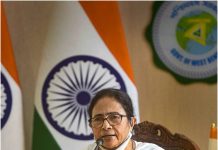When on May 3, Colonel Ashutosh Sharma learnt about the militants taking hostage the civilians at Changimulla in North Kashmir’s Handwara, he headed to the spot along with the major Anuj Sood, two soldiers and one J&K Police sub-inspector Sageer Ahmad Pathan. With Colonel Sharma leading from the front, the team entered the target area occupied by the militants to evacuate the civilians. They were able to extricate the civilians. But in the process, they came under “a heavy volume of fire” from the militants. In the ensuing firefight, the two militants were killed while as the five security personnel including Sharma too lost their lives.
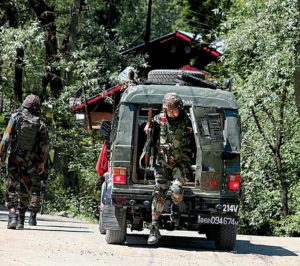 Originally from Bulandshahr in Uttar Pradesh, Colonel Sharma had been part of several successful counter-insurgency operations in Kashmir in the past many years. He was twice awarded Sena medal for gallantry, including one for bravery as Commanding Officer (CO). He received the gallantry award as a CO when he shot a militant who was rushing towards his men on a road with a grenade hidden in his clothes.
Originally from Bulandshahr in Uttar Pradesh, Colonel Sharma had been part of several successful counter-insurgency operations in Kashmir in the past many years. He was twice awarded Sena medal for gallantry, including one for bravery as Commanding Officer (CO). He received the gallantry award as a CO when he shot a militant who was rushing towards his men on a road with a grenade hidden in his clothes.
Col Sharma is the first colonel rank officer in the last five years to have lost life in an encounter with militants. Before this, the Army had lost two colonel-ranking officers in separate terror incidents in 2015. Col Sharma is survived by his wife and a twelve years old daughter.
Similarly, Major Sood who made the supreme sacrifice in the encounter had married only a few months ago. His family received the news of his death the same day as he was scheduled to return home. He had finished his two-year stint in J&K in March but had been told to stay on due to the lockdown. His father Brigadier (retd) C K Sood told media that Sood was to come home for a month-long leave and then join at Gurdaspur in Punjab. Major Sood was the third generation of the family in the Army.
The killing of Sharma and Sood was followed a day later by the killing of the three more security personnel in an ambush in the same district. It capped a month of intense militancy related violence in the Valley. In this month that also happened to be the period of coronavirus lockdown in Kashmir, security forces killed around thirty militants revealing a steep escalation in the violence in the union territory during the pandemic. In addition, sixteen security personnel including colonel Sharma, Major Sood and five para commandos also died. As against this just nine people have died due to Covid-19.
The new cycle of violence began in the first week of April when five soldiers and five militants lost their lives in a hand to hand combat in Operation Randori Behak in Keran sector near Line of Control. On receiving the information about an infiltrating group of militants, Army had flown its soldiers to the spot to take them on. It was a difficult hilly terrain, still heavily snowbound at the time , making it difficult to track the militants down. But while the Army eventually eliminated the infiltrators, the five soldiers also lost their lives.
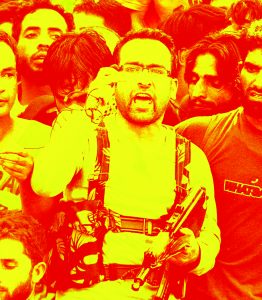 However, following these reverses, security forces on May 5 killed the Hizbul Mujiahideen operational chief Riyaz Naikoo at his native village Beighpora in South Kashmir. Naikoo had been active on the scene over the past eight years. This was the biggest success for the security agencies after the last year’s killing of Zakir Musa, the commander of Ansar Gazwat-ul-Hind, the Kashmir chapter of Al Qaeda.
However, following these reverses, security forces on May 5 killed the Hizbul Mujiahideen operational chief Riyaz Naikoo at his native village Beighpora in South Kashmir. Naikoo had been active on the scene over the past eight years. This was the biggest success for the security agencies after the last year’s killing of Zakir Musa, the commander of Ansar Gazwat-ul-Hind, the Kashmir chapter of Al Qaeda.
The complete focus on the fight against Coronavirus has, however, taken the attention away from the ongoing violence. But given the dramatic nature of the escalation both in the Valley and on the Line of Control that too led to killings of four civilians, including that of a six-year-old, the omens for the summer are not good.
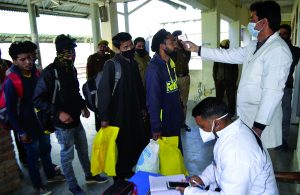 “The rise of violence at a time when India and Pakistan desperately need to attend to the proliferating Covid-19 patients is troubling but along expected lines” says the columnist Naseer Ahmad. “We can only hope it doesn’t extend into summer”.
“The rise of violence at a time when India and Pakistan desperately need to attend to the proliferating Covid-19 patients is troubling but along expected lines” says the columnist Naseer Ahmad. “We can only hope it doesn’t extend into summer”.
The sudden eruption in LoC skirmishes is put down by security agencies as the consequence of Pakistan’s attempt to push in militants. And the killing of security personnel by the militants who had just crossed over validates the claim. Almost all of the militants who died in encounters or carried out ambushes were Kashmiris who had trained in Pakistan Occupied Kashmir. Their families in South Kashmir laid a claim to their bodies at the respective police stations. However, police refused to hand them over lest it lead to a large funeral. Their bodies were buried somewhere in North Kashmir.
The security situation as it is evolving has dimensions beyond the recent violent incidents. One, the violence at such a scale has taken place for the first time after the revocation of Article 370 in August last. This has once again hurtled the militancy to the centre stage and doesn’t augur well for the summer ahead.
Second, the attacks have been claimed by a new militant outfit The Resistance Front (TRF). In addition, one more militant outfit Tehreek-i-Milat-i-Islami (TMI) has announced its birth. And both claim their origins are indigenous. There is no longer any mention of Lashkar-i-Toiba or Jaish-e-Mohammad. This is a far-reaching omission, and shows an effort to project Kashmir militancy as a home-bred affair.
If that be so, this will be first time in the past thirty years, that a deliberate attempt is afoot to make Kashmir militancy look indigenous. This may be the outcome of the diminishing returns of the actions in Kashmir of Pakistan based militant outfits like Lashkar and Jaish. More so after the last year’s Pulwama attack owned by Jaish which killed forty CRPF personnel and nearly brought India and Pakistan to war.
“Resistance Front is a proxy for Lashkar. Its secular sounding name is a deliberate attempt to show the terrorism in Kashmir is a political movement, not religious,” said a police officer. “This is an attempt at image makeover”.
Dramatic revival
The violence has resurfaced at a time when the militancy was giving all indications of being in retreat. According to police estimate there are around 250 active militants in Kashmir, of which around fifty have been killed since January. Besides, months following the revocation of Article 370 had witnessed a drop in Kashmiri youth taking to arms. And this was expected to lead to a progressive dwindling of the number of militants.
But the fresh killings have turned these calculations on their head. It has made it clear that the militancy is not going anywhere. The infiltration remains an ongoing phenomenon, the hi-tech border fencing notwithstanding. And the militants that are crossing over are highly trained and battle-hardened, considering the fact that they even killed five paratroopers who were alleged to have participated in September 2016 surgical strike against Pakistan
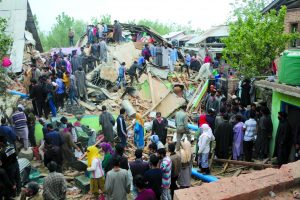 If anything, it shows that Kashmiri youth are once again crossing the border for arms training in Pakistan and Pakistan Occupied Kashmir. In some cases, the youth are said to have visited Pakistan on valid visa through Wagah border. This was not the case over the past one and a half decade. The youth would join militancy and train locally. But these armed youth have had little more than a symbolic value as their rudimentary training often makes them sitting ducks for the security personnel in encounter after encounter. In South Kashmir, hardly any security personnel has died in an encounter with the militants over the past year. Most militants die within few hours of being tracked down. In many cases, security forces have taken to blowing up the houses where militants are holed up.
If anything, it shows that Kashmiri youth are once again crossing the border for arms training in Pakistan and Pakistan Occupied Kashmir. In some cases, the youth are said to have visited Pakistan on valid visa through Wagah border. This was not the case over the past one and a half decade. The youth would join militancy and train locally. But these armed youth have had little more than a symbolic value as their rudimentary training often makes them sitting ducks for the security personnel in encounter after encounter. In South Kashmir, hardly any security personnel has died in an encounter with the militants over the past year. Most militants die within few hours of being tracked down. In many cases, security forces have taken to blowing up the houses where militants are holed up.
But that Kashmiris are once again seeking an advanced arms training across the border, should be a cause for grave concern for the security agencies. According to police sources, the militants who manage to exfilterate get six months of training in handling arms. This reflects in the loss they have inflicted on the security personnel over the past month.
“The spike in the militancy hasn’t taken us by surprise. We expected the militancy to rear its head around this time,” said a senior police officer. “But we will deal with it and reign it in sooner than later”.
New rationale
Import of the new violence, however, goes beyond Kashmiri youth crossing over for training, and also beyond its heavy toll. Its significance lies in that the militancy in the Valley is not a lost cause that it was expected to be in the wake of nullification of J&K autonomy. On the contrary, stripping Kashmir of the autonomy may have only enhanced the rationale for an armed struggle, more so, with democratic political activity in the region reduced to zero over the past nine months. After nullification of Article 370 New Delhi has barred even the normal mainstream politics in Kashmir, let alone allow the functioning of separatist politics. What is more, even Facebook posts, often even those innocuous in their import, invite legal action. This has curbed all space for dissent.
What is more, before August 5, the militancy and the public protests were exclusively secessionist in nature, not participated by the pro-establishment parties. The grievance in Kashmir now spans across the board. And its expression in near and medium term is likely to be even more antagonistic towards New Delhi.
It is against this backdrop that the fresh infiltration is taking place. The militants who are coming also include Kashmiris as against just the Pakistani militants as was the case earlier. As it is, the Covid-19 pandemic hasn’t stopped the flow. In fact, the melting snow along the LoC has only given fillip to these arrivals. And if the influx of militants continues, as looks likely, it could confront New Delhi with a formidable challenge in the months to come.
What would be interesting to see is if more Pakistan based militants join the battle in Kashmir. Ever since the new wave of the local militancy triggered by the advent of Burhan Wani in 2015, Kashmiri militants have general outnumbered their foreign counterparts. Any considerable change in the ratio in favour of the foreigners could dramatically change the landscape of militancy in Kashmir. As of now, however, much of this scenario is in the realm of speculation. But the fresh violence has made this prospect a more realistic proposition than it otherwise would have been.
Militancy trends
Revival of militancy in March marks a new phase in its three decade long history. In these years, militancy has ebbed and flowed. While a large number of militants hasn’t undermined the grip of security forces, a drastic reduction in the number of militants has hardly lessened the challenge of militancy. On the contrary, a constant and commensurate replenishment has kept the militancy alive and kicking. And that too when the Valley had no more than hundred militants — a figure of 2012-13 — and South Kashmir which now boasts of around 200militants had just 15 of them.
Over the decade before 2015, every year the security forces killed an average of 100 militants which also used to be the total number of active militants in the Valley. But the militancy survived, replenished mostly by the foreigners. After 2015, the emergence of Burhan Wani altered the complexion of militancy now largely composed of the local boys. Foreign versus local militant ratio once again changed in favour of the local militants. Ever since killings of the militants have produced more local recruits.
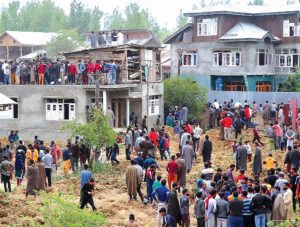 However, this recruitment has remained largely centered in South Kashmir with central and north Kashmir least impacted by the fallout. In the months following Wani’s killing in 2016, the number of militants in the Valley went up twofold to around 300, most of them from South Kashmir and concentrated there.
However, this recruitment has remained largely centered in South Kashmir with central and north Kashmir least impacted by the fallout. In the months following Wani’s killing in 2016, the number of militants in the Valley went up twofold to around 300, most of them from South Kashmir and concentrated there.
A reason for this was the overwhelming public support that the militancy enjoyed in the region. This was demonstrated by the dramatic rise in the number of people participating in militant funerals. Each militant killing unfolded a spectacle of deep mourning: Body would be kept in the largest available ground in the area which soon filled to the standing room with a throbbing and shoving mass of mourners. Arms would go up and pro-Azadi slogans rent the air. Women cried, many of them losing consciousness on seeing the body. The mourning and anger didn’t subside with the burial. The funeral invariably led to protests across a wide swathe of the area.
Similarly, there were also protests when militants were tracked down and cordoned off by the security forces. Swarms of the youth disrupted the encounter sites, throwing their lives on the line. An estimated 50 civilians have lost their lives in the attempts to save militants.
This hero-worship inspired more local youth to join the militancy. As a result, despite the increased killings of the gunmen, militancy continued. In fact, the killings fanned rather than deterred the militancy.
But the government didn’t budge. It pressed on with a hardline security response to eliminate militancy. In 2016 and 2017 security agencies christened the campaign against militancy as Operation All Out. The objective was to eliminate insurgency by attempting to kill all the militants within a specific timeframe. They met with an overwhelming success managing to kill a significant number of militants and it drastically reduced their count by around a hundred in a matter of few months. From 300, the number of active militants again settled around 200. For a while, this did alter the political dynamics in the Valley, the deeper factors underpinning the current state of affairs lingered on, gestating conditions for yet another phase of violence and unrest.
Graph of fatalities
According to South Asia Terrorism Portal, the militancy related fatalities started going down in Kashmir from 2003 onwards. From 2542 killings in the year, the number went down to 777 by 2007. It declined to its lowest at 117 in 2012. But since then the killings have been on rise again. While in 2013 it was 181, in 2014 and 2015 it was 193 and 174 respectively, in 2016 it went up to 267.
However, 2018 turned out to be the deadliest year in a decade. At least 586 people died in different incidents of violence. Among the killed were160 civilians, 267 militants and 159 members of Indian armed forces and Jammu and Kashmir police. The killing of 267 militants during encounters with armed forces and police was also the highest in the preceding decade.
Incidentally, the decade of rising violence in Kashmir coincided with suspension of the engagement by New Delhi, both with Pakistan and Kashmiri separatist groups. A security hardline taken by the BJP-led union government at the centre has met an even harder line in Kashmir. Militant recruitment has increased and the ideological discourse has hardened – albeit both to the detriment of Kashmir.
A harsh security response to the situation has brought untold suffering for the common people in its wake. And this suffering has increased manifold after withdrawal of Article 370. Six month long lockdown coupled with an unprecedented communication clampdown and hundreds of arrests of politicians, civil society activists and protesters has hit people, businesses, education etc hard. And just when Kashmir was emerging from the lockdown, it was plunged right back into it by the outbreak of Covid-19, with militancy-related violence to boot.
Confronting the new challenge
How security agencies will tackle the challenge of a re-invigorated militancy? The killings of the security personnel over the past month in North Kashmir would call for a response other than that adopted in South Kashmir.
“We are facing two different forms of militancy in North and South Kashmir,” says a police officer. “North has trained militants who have infiltrated across the border and South has predominantly local militants who are locally and poorly trained. So, North will need more attention”.
At the same time, forces are concerned about the fresh spike in local militant recruitment. “Kashmir militancy is kept alive by fluctuating local recruitment supported by Pakistani militants. Ratio between them keeps changing,” says the officer. “But the key to reducing the footprint of militancy or eliminating it lies in checking the local recruitment. This is easier said than done”.
However, J&K Police supported by Army and paramiliatries has three decades of counterinsurgency experience. Over the past two decades, it has emerged as the main force in the union territory battling the militancy.
But the challenge for it could grow several fold if the number of militants rises in Kashmir. “Militancy over the past two decades has comprised 200 to 250 militants annually. Now, there seems an attempt by Pakistan to raise this number to increase the level of violence by sending in more militants,” said a police officer. “But we are prepared for the challenge”.
Afghan angle
There will be a definite fallout on Kashmir of the expected shift in the regional geo-politics after the likely take-over of Afghanistan by Taliban in near to medium future following their recent agreement with the US. There’s a fear and a possibility that Afghan mujahideen might wend their way back to Kashmir. And if the former Indian spy chief A S Dulat is to be believed, Afghan militants may already be in Kashmir. Dulat recently told an online portal that “around 50 foreigners — Pakistanis, Afghans, Arabs, Turks — had crossed into Kashmir in recent weeks.
To get a sense of how presence of Afghan militants could drastically alter the ground situation in the Valley it is important to revisit the situation in Kashmir from mid-nineties when Taliban took over in Kabul to up until 9/11 following which Taliban regime was toppled. Apart from a steep spike in militant violence in the region, this period is marked by hijacking of 1C-814 to Kabul and Kargil war.
There is a chance that a similar scenario could replay in Kashmir. More so, in the wake of India’s withdrawal of Kashmir’s autonomy which Pakistan, Taliban’s benefactor, has vowed to resist and Kashmiris want to be undone.
It is also true that the geo-political context now is markedly different from the nineties and Taliban itself may not be keen to get involved. But a return to Taliban rule in Afghanistan will be too big a geopolitical development, not to leave regional situation including Kashmir unimpacted.
All such factors don’t bode well for the situation in Kashmir and India-Pakistan relations. Before we know it, the two countries could once again find themselves on the brink of a Balakot-like situation.
“It is important that New Delhi takes measures to address the fast changing situation in Kashmir,” said a local politician who didn’t want to be identified.”There is an urgent need for a political outreach that seeks to address the fears and anxieties generated by arbitrary revocation of Article 370”.
At the same time, the politician added, the violence is unlikely to die down until India and Pakistan talk and initiate a process towards resolution of all their issues including Kashmir. “There is a precedent for it. During the five year period of peace process between India and Pakistan from 2003 to 2007, there was a drastic decline in violence in Kashmir,” he said. “The neighbours need a replication of the same process”.
It was the former Prime Minister Atal Bihari Vajpayee who had begun the promising negotiations with Musharraf which were later followed up by the former Prime Minister Manmohan Singh. The process had nearly culminated into a Kashmir solution by the end of 2007 when Musharraf’s sudden loss of power and later on the Mumbai attacks aborted it.
However, there is a lot that has happened since. The dynamics that had made the engagement possible then no longer obtain. More so after the withdrawal of J&K autonomy. Besides several new factors are at play in the regional geo-politics and in the relations between the two countries that have made it increasingly difficult to resume the peace process.
So, any dialogue is unlikely to happen anytime soon. Kashmir is too complex an issue to be resolved in a certain timeframe. The situation in Kashmir seems set to follow the pattern of the past three decades. And this is a distressing prospect for the state. It means the suffering will unfortunately go on. And this war of attrition will have no end. “Yes, resolving Kashmir is a long term project but this is the end towards which all the efforts should be geared,” says the politician. “And these efforts have to be predominantly centred around politics than a military approach that hardly yields a solution”.
letters@tehelka.com










